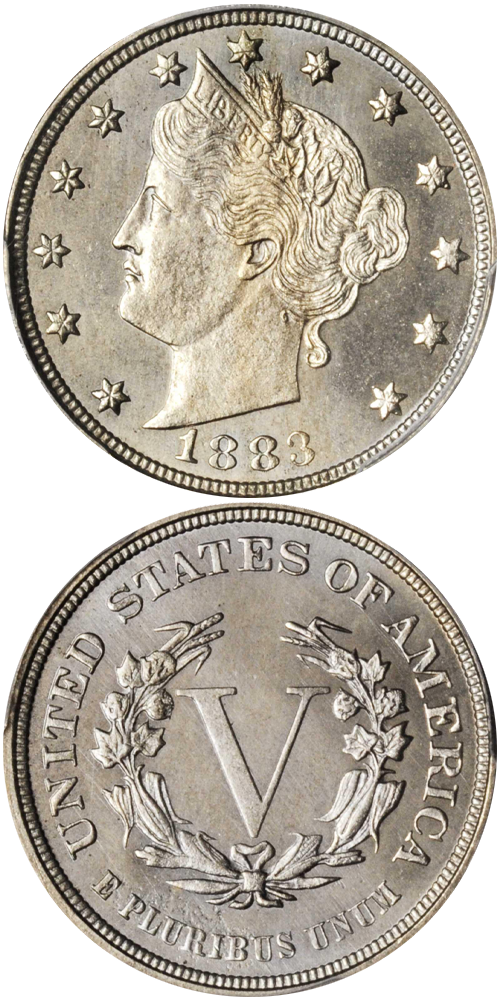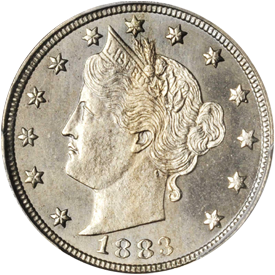Designed by: Charles E. Barber
Issue Date: 1883
Composition: 75% copper, 25% nickel
Diameter: 21.2 mm
Weight: 5.00 grams (77.16 grains)
Edge: Plain
Business Strike Mintage: 5,474,000
The Liberty or “V” nickel, a design by Charles E. Barber (later responsible for the dime, quarter and half in 1892) appeared in 1883. The first design did not feature the word “CENTS” on the reverse – mint officials believing that the metal and size would be sufficient for the public to know it was a five-cent coin. Clever con artists gold plated the coins, with some even adding reeding on the edge, and attempted to pass them as $5 gold pieces. The mint, realizing their omission, quickly corrected the problem, and later in 1883, new coins appeared with the word “CENTS” below the large “V” on the reverse.
The ”V” nickel was a most useful coin throughout its roughly 30-year life, as the purchasing power of a nickel during that period was roughly equal to $1.00 (or even more) today. As a consequence, many were worn down to AG or Good condition due to their extremely active life in everyday circulation. Coins in Fine to EF condition are reasonably scarce to find today.
Further Reading
Beginning in 1881, patterns were made for the so-called Liberty Head nickel design. The obverse featured a classic head of Miss Liberty, modeled after the goddess Diana it was said, a design which was considered at the time to be superior to the Shield motif. Liberty Head patterns were prepared of the one-cent, three-cent, and five-cent denominations. The value of each was stated in Roman numerals on the reverse, I, III, and V. No such standardization across these denominations was ever to take place, and the one-cent and three-cent pieces of this design were soon forgotten.
The Liberty Head motif lingered on for use with the nickel five-cent piece, and in 1882, many different patterns were produced. The obverse of most of these featured a head of Liberty surrounded by the legend UNITED STATES OF AMERICA. On the reverse the value was stated as V in combination with various wreaths and inscriptions. One piece, listed now as Judd-1690 in United States Patterns, is identical to the regular without-CENTS issue of the following year, 1883. This important transitional pattern has been a favorite with collectors. Around 1960 a specimen of this coin was displayed at one of the Central States Numismatic Society conventions. All by itself in solitary splendor the coin earned a prize! The 1882 Liberty nickel has great numismatic interest, just as the piece at the tail-end of the series, the 1913 Liberty nickel.
In 1883 the first regular Liberty nickels were made for circulation. The earliest design bore as a denomination the large letter V on the reverse. The word CENTS was not present. No one at the Mint gave any thought to a potential problem, for the pieces looked like nickels and were the size and shape of the then-familiar Shield types. However, the Mint did not reckon with the ingenuity of American citizens.
No sooner did the new Liberty nickels without CENTS appear than an interesting type of fraud was perpetrated with them. Certain individuals gold-plated the new nickels, and some with machining facilities even added reeded edges. As the diameter of the nickel is approximately the same as that of the United States $5 gold piece, a gold-plated Liberty nickel could be mistaken for a $5 gold piece of a new design. At this time the Liberty nickel design was not familiar to the public as a design for nickels, so anyone seeing such a gold-plated piece had no reason to attribute it to a lower value. The numeral V on the reverse, of course, could equally stand for $5 or 5c.
Gold-plated 1883 without-CENTS nickels were evidently made in large quantities, for specimens are often seen today with traces of gold plating made years ago. The story of these pieces, often called "racketeer nickels" today, has been recounted numerous times in numismatic literature. It has been related that one of the favorite ways to pass such pieces back in 1883 was not to offer one and say, "Here is a five-dollar gold piece, please give me change," but, rather, to purchase something such as a cigar or a piece of candy with a value of one or two cents.
The 1883 Liberty nickel plated to resemble a $5 gold piece would be tendered in payment. No words would be said. If the shopkeeper then gave $4.98 in change for a two-cent purchase, then the deception was complete. But, for legal purposes the person spending the nickel had not stated that it was a $5 gold piece and could claim complete innocence in the matter! On the other hand, should the shopkeeper return only three cents, realizing that it was a nickel, then the owner of the nickel could ask for that coin back and give him another one which had not been gold plated.
The Mint soon realized that it had made a mistake in the design. So, later in the year 1883 the word CENTS was added to the reverse. From 1883 through 1913 the design remained this style.
News of the Mint's oversight spread rapidly, and it was said that all of the error nickels without CENTS would be recalled. This precipitated a wild scramble, and vast quantities were squirreled away in bureau drawers, toy banks, and other locations. Feeding on this untrue rumor, sellers of coins and curiosities found a ready profit could be turned by selling such pieces to speculators and investors. As late as October 1886, long after the hoarding fervor had passed, John M. Hubbard, an early coin and stamp dealer, ran the following notice:
"The government has been calling in the V nickels of 1883 without CENTS ever since their coinage was stopped. They are melted and coined into the common nickels. We have a few of the variety without CENTS which we are selling at 15c each. Everyone who does not own a specimen should procure one at once as in a short time they will cost much more."
Eventually 1883 without-CENTS nickels purchased at three times face value in 1886 proved to be good investments, but not until more than a half century later. As recently as the 1940s, specimens traded hands in bulk quantities at just slightly over face value. With the advent of the popularity of type set collecting around 1960, the 1883 without¬ CENTS nickel became the object of desire for thousands of new buyers, for such a coin was absolutely necessary to complete a grouping of nickels by designs. Year by year the price rose as the demand increased. Today large quantities are seldom seen, and Choice Uncirculated individual specimens are highly desired. It is also the most plentiful Liberty nickel in grades above Very Fine. Specimens are easily obtained and demand for them is widespread.







